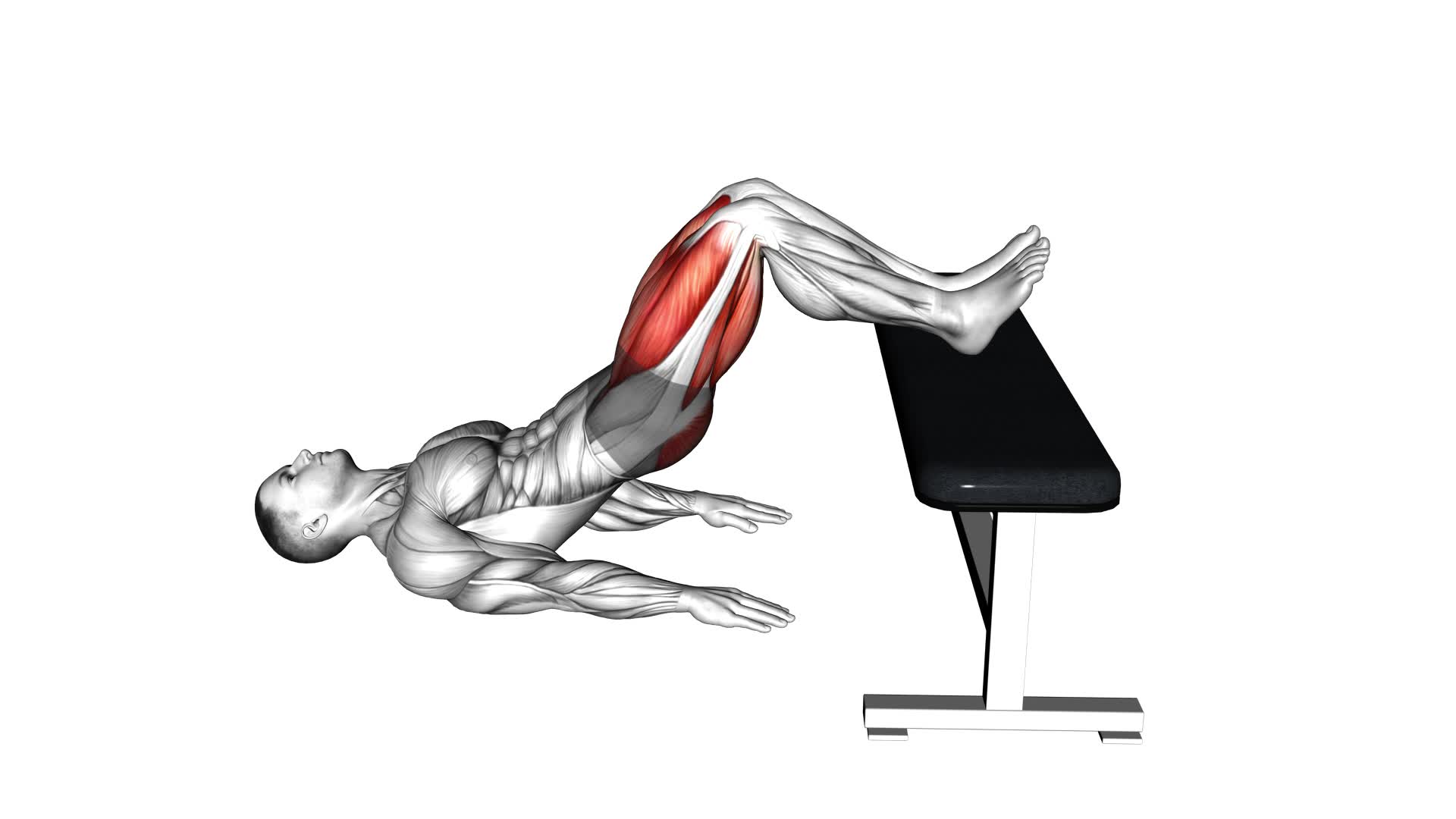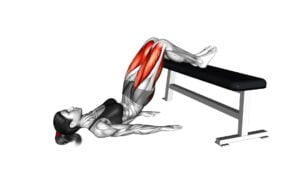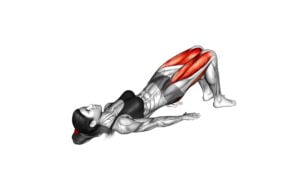Glute Bridge Two Legs on Bench (male) – Video Exercise Guide & Tips

Are you looking to strengthen your glutes and improve your lower body strength?
Watch This Exercise Video
The Glute Bridge Two Legs on Bench exercise is just what you need. This video exercise guide will show you the proper form and technique, along with variations and progressions to challenge yourself.
Avoid common mistakes and maximize your workout with these helpful tips.
Get ready to feel the burn and take your glute training to the next level.
Let's get started!
Key Takeaways
- Strengthen glutes and improve lower body strength
- Target gluteal muscles, specifically the gluteus maximus
- Increase activation of gluteus medius and improve hip stability with single-leg variation
- Provide a greater range of motion and intense workout with hip thrust variation
Benefits of the Glute Bridge Exercise
You can experience significant strength and muscle gains in your glutes by regularly performing the glute bridge exercise. The glute bridge is a simple yet effective exercise that targets the gluteal muscles, specifically the gluteus maximus. This exercise involves lying on your back with your knees bent and feet flat on the ground, then lifting your hips off the floor while squeezing your glutes.
To maximize your glute bridge workout, you can incorporate different variations of the exercise. One variation is the single-leg glute bridge, where you lift one leg off the ground while performing the bridge. This variation increases the activation of the gluteus medius and helps to improve hip stability.
Another variation is the hip thrust, which involves using a bench or elevated surface to support your upper back while performing the bridge. This variation allows for a greater range of motion and provides a more intense workout for the glutes.
In addition to variations, you can also make your glute bridge workout more challenging by adding resistance. You can use a resistance band around your thighs or place a weight plate on your hips to increase the difficulty and stimulate further muscle growth.
Equipment Needed for the Exercise
To perform the Glute Bridge Two Legs on Bench exercise, you'll need a bench or elevated surface for support. Here is a list of the equipment needed for this exercise:
- Bench or Elevated Surface: Choose a sturdy bench or elevated surface that can support your weight. It should be wide enough to comfortably accommodate your shoulders and provide stability during the exercise.
- Exercise Mat: While not essential, an exercise mat can provide additional comfort and support for your back and shoulders. It can also help prevent slipping during the exercise.
- Resistance Band (Optional): Adding a resistance band to this exercise can increase the intensity and challenge your glute muscles even more. Simply place the band around your thighs, just above your knees, to add resistance as you raise your hips.
- Dumbbells (Optional): If you want to further increase the difficulty of the exercise, you can hold a pair of dumbbells on your hips while performing the glute bridge. This will add extra resistance and engage your glutes even more.
Proper Form and Technique
To perform the Glute Bridge Two Legs on Bench exercise with proper form and technique, there are a few key points to keep in mind.
First, ensure that your body is aligned correctly by lying flat on your back with your feet hip-width apart and your knees bent.
Secondly, focus on your breathing during the exercise, exhaling as you lift your hips off the ground and inhaling as you lower them back down.
Lastly, be aware of common form mistakes, such as arching your back or pushing through your toes instead of your heels, and make adjustments as needed to maintain proper form throughout the exercise.
Body Alignment Tips
The proper form and technique for body alignment in the Glute Bridge Two Legs on Bench exercise can be achieved by focusing on your core engagement and maintaining a neutral spine position. Here are some tips to help you optimize your body alignment during this exercise:
- Start by lying on your back with your feet flat on the bench, hip-width apart.
- Engage your core by drawing your belly button towards your spine.
- Keep your knees in line with your hips as you lift your hips off the ground.
- Maintain a neutral spine by avoiding excessive arching or rounding of your lower back.
By following these body alignment techniques and glute activation strategies, you can ensure that you target the right muscles and minimize the risk of injury.
Now, let's move on to the next important aspect of this exercise: breathing during exercise.
Breathing During Exercise
Breathe in and out rhythmically to maintain proper form and technique during the Glute Bridge Two Legs on Bench exercise.
Proper breathing techniques are essential for optimizing performance and preventing injury during exercise. When performing the Glute Bridge exercise, it's important to establish optimal breathing patterns to ensure efficient oxygen exchange and stability throughout the movement.
As you lower your hips towards the ground, inhale deeply through your nose, expanding your diaphragm and filling your lungs. As you lift your hips off the ground and contract your glutes, exhale fully through your mouth, engaging your core muscles.
This rhythmic breathing pattern helps stabilize your body and maintain proper form, allowing you to generate maximum power and effectively target your glute muscles.
Remember to focus on your breath and maintain a steady rhythm throughout the exercise.
Common Form Mistakes
When performing the Glute Bridge Two Legs on Bench exercise, it's important to be aware of common form mistakes to ensure proper form and technique. Here are some common errors to avoid:
- Arching your back: Keep your back flat against the bench throughout the movement. Arching can put unnecessary strain on your lower back.
- Not engaging your glutes: The purpose of this exercise is to target the glute muscles. Make sure to squeeze your glutes at the top of the movement to activate them fully.
- Raising your hips too high: While it's important to lift your hips off the ground, avoid overextending and raising them too high. This can lead to hyperextension and take the focus away from your glutes.
- Using momentum: Remember to perform the exercise in a controlled manner. Avoid using momentum to lift your hips and focus on using your glutes to drive the movement.
Variations and Progressions
Now that you have mastered the proper form and technique of the Glute Bridge Two Legs on Bench exercise, it's time to explore advanced progressions and variations.
These advanced progressions will help you further challenge your glutes and increase strength and stability.
Additionally, incorporating variations into your routine can target different muscle groups and provide a well-rounded lower body workout.
Advanced Progressions for Glute Bridge
To advance your glute bridge exercise, incorporate variations and progressions. Here are four advanced modifications and glute activation techniques to take your glute bridge to the next level:
- Single-leg Glute Bridge: Lift one leg off the ground and perform the glute bridge using only the other leg. This increases the demand on your glutes and challenges your balance.
- Weighted Glute Bridge: Place a weight, such as a barbell or dumbbell, across your hips while performing the glute bridge. This adds resistance and intensifies the exercise.
- Banded Glute Bridge: Wrap a resistance band around your thighs, just above your knees, and perform the glute bridge. The band provides external resistance, activating your glutes even more.
- Elevated Glute Bridge: Place your feet on an elevated surface, such as a step or bench, and perform the glute bridge. This increases the range of motion and further targets your glutes.
Incorporating these advanced progressions will help you achieve greater strength and activation in your glutes.
Now, let's explore the benefits of these variations.
Benefits of Variations
To experience the benefits of these advanced glute bridge variations and progressions, incorporate them into your workout routine.
Glute bridge variations provide a great way to target and strengthen your glutes, hamstrings, and core muscles. By adding variations to your routine, you can challenge your muscles in different ways and prevent plateaus in your progress.
For example, you can try the single-leg glute bridge variation to increase the intensity and engage your glutes even more. Another variation is the glute bridge with a resistance band, which adds resistance to the exercise and further activates your glute muscles.
Progressions, on the other hand, allow you to gradually increase the difficulty of the exercise. These can include elevating your feet on a bench or using a stability ball.
Incorporating glute bridge variations and progressions won't only help you build a stronger lower body but also improve your overall stability and posture.
Common Mistakes to Avoid
Ensure proper form and technique by avoiding these common mistakes when performing the Glute Bridge Two Legs on Bench exercise.
- Improper alignment: One of the most common mistakes is failing to maintain proper alignment during the exercise. Make sure your feet are firmly planted on the bench and your knees are directly above your ankles. This will help prevent any strain on your lower back and ensure that you're targeting your glutes effectively.
- Holding your breath: Many people tend to hold their breath while performing the glute bridge. This can lead to unnecessary tension and limit the effectiveness of the exercise. Remember to breathe in through your nose and exhale through your mouth throughout the movement. This will help you maintain a steady flow of oxygen to your muscles, allowing for better performance and results.
- Rushing through the movement: Another mistake to avoid is rushing through the glute bridge exercise. Take your time and focus on squeezing your glutes at the top of the movement, then slowly lower yourself back down. This will ensure that you're engaging your glute muscles fully and getting the most out of each repetition.
- Lifting your hips too high: While it's important to fully extend your hips during the glute bridge, lifting your hips too high can put unnecessary strain on your lower back. Aim to create a straight line from your knees to your hips and shoulders when in the top position. This will help maintain proper form and prevent any discomfort or injury.
By avoiding these common mistakes, you'll be able to perform the Glute Bridge Two Legs on Bench exercise with proper form and technique, maximizing its benefits.
Now, let's move on to the next section where we'll discuss some tips for maximizing your glute bridge workout.
Tips for Maximizing Your Glute Bridge Workout
To maximize your glute bridge workout, focus on engaging your glutes throughout the entire exercise movement. This is essential for targeting and strengthening your glute muscles effectively. One tip for achieving this is to squeeze your glutes at the top of the bridge and hold for a brief moment before lowering back down. This helps to activate and fully engage your glutes.
Another way to maximize your glute bridge workout is to incorporate variations into your routine. This can include single-leg glute bridges, where you raise one leg off the ground while performing the exercise. This variation increases the intensity and challenges your glutes even more.
Additionally, you can try using a resistance band around your thighs to add extra resistance and work your glutes from different angles.
The benefits of the glute bridge exercise are numerous. It strengthens and tones your glutes, improves hip stability, and enhances athletic performance.
Frequently Asked Questions
How Many Reps and Sets Should I Do for the Glute Bridge Exercise?
To maximize the benefits of glute bridges, it's important to determine the right number of reps and sets for your workout. The number of reps refers to the amount of times you perform the exercise in a set, while sets are the total rounds of reps.
The ideal number of reps and sets for the glute bridge exercise may vary depending on your fitness level and goals. It's recommended to start with 2-3 sets of 10-15 reps, gradually increasing the intensity as you progress.
Can the Glute Bridge Exercise Help With Lower Back Pain?
Yes, the glute bridge exercise can help with lower back pain. By strengthening your glutes and core muscles, it improves your posture and provides support to your lower back.
Additionally, there are various glute bridge modifications you can try to target different muscle groups and alleviate pain.
The benefits of the glute bridge for posture include improved alignment, reduced strain on the lower back, and increased stability.
Incorporating this exercise into your routine can be an effective way to address lower back pain and improve overall posture.
Is It Necessary to Use a Bench for the Glute Bridge Exercise, or Can I Do It on the Floor?
To answer your question, using a bench for the glute bridge exercise isn't necessary. You can perform the exercise on the floor as well.
However, using a bench offers certain benefits. It allows for a greater range of motion, activating more muscles in your glutes and hamstrings. Additionally, the elevation provided by the bench increases the challenge and intensity of the exercise.
Ultimately, the choice between the floor and the bench depends on your personal preference and fitness goals.
Can the Glute Bridge Exercise Help Improve Athletic Performance?
The glute bridge exercise is an effective way to improve your athletic performance. By strengthening your glutes, it can help enhance your explosiveness and power, which is beneficial for sprinters.
This exercise targets the posterior chain muscles, including the glutes, hamstrings, and lower back, which are crucial for generating speed and power.
Incorporating the glute bridge into your training routine can have significant benefits for sprinters, leading to improved performance on the track.
Are There Any Specific Breathing Techniques I Should Follow During the Glute Bridge Exercise?
During the glute bridge exercise, it's important to focus on your breathing techniques. Proper breathing can enhance the effectiveness of the exercise and help you maintain stability.
As you lift your hips off the ground, exhale and engage your core muscles. Inhale as you lower your hips back down.
This controlled breathing pattern can improve your overall strength and stability, allowing you to get the most out of the glute bridge exercise.
Conclusion
In conclusion, the glute bridge exercise is an effective way to target and strengthen the glute muscles. By using proper form and technique, you can maximize the benefits of this exercise.
It requires minimal equipment and can be easily modified to suit your fitness level. Avoiding common mistakes and following these tips will help you get the most out of your glute bridge workout.
So grab a bench and start working those glutes for a stronger and more sculpted lower body.

Author
Years ago, the spark of my life’s passion ignited in my mind the moment I stepped into the local gym for the first time. The inaugural bead of perspiration, the initial endeavor, the very first surge of endorphins, and a sense of pride that washed over me post-workout marked the beginning of my deep-seated interest in strength sports, fitness, and sports nutrition. This very curiosity blossomed rapidly into a profound fascination, propelling me to earn a Master’s degree in Physical Education from the Academy of Physical Education in Krakow, followed by a Sports Manager diploma from the Jagiellonian University. My journey of growth led me to gain more specialized qualifications, such as being a certified personal trainer with a focus on sports dietetics, a lifeguard, and an instructor for wellness and corrective gymnastics. Theoretical knowledge paired seamlessly with practical experience, reinforcing my belief that the transformation of individuals under my guidance was also a reflection of my personal growth. This belief holds true even today. Each day, I strive to push the boundaries and explore new realms. These realms gently elevate me to greater heights. The unique combination of passion for my field and the continuous quest for growth fuels my drive to break new ground.



